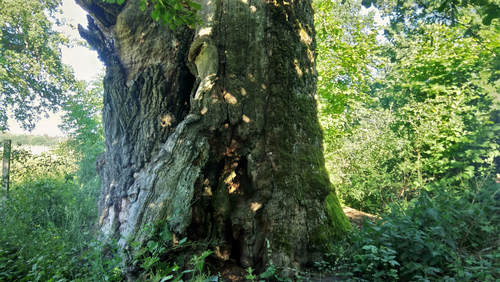The Oak Tree - Symbol for Strength
The European oak or common oak (Quercus robur) is one of around 500 oak species worldwide. In Sweden the oak trees grow up to 20-25 meters in height while they can reach up to 45 meters in Southern Europe.
After the last ice age, about 9.000 years ago, the European oak made its way north and spread around Southern and Middle Sweden. It prefers clayey and humus-rich soil; however, it is quite tolerant and can also grow on rocky terrain. Its tolerance is of great advantage, since the oak tree can reach an age of more than 1000 years. In this time-span, circumstances can greatly change even at the same spot.
Compared to for example beach trees, the oak does not grow in what could be called the social system and intergenerational network of the forest. Oak trees are strongest on their own and can therefore often be found lone standing in the fields or on open meadows. Through its extremely strong and deep taproot Quercus robur stands strong in storms even without the protection a forest could provide.
Have you noticed that big oak trees often are greatly damaged as they were facing storms and lightnings in their exposed habitats? Even the entire crown might have fallen in certain cases. However, the rest of the tree still stands strong and alive for many more decades or even centuries! This is more than other tree species would tolerate. If a maple or beach tree loses a big branch, the resulting wound will allow fungi to enter the wood and the tree starts to get rotten from the inside. After a couple of decades, it has most probably died. Not the oak tree though. Its wood contains tannins which serve as antifungal agent and allow the tree to recover to an extent that it can even build a second crown once the main crown was lost through storm or lightning.
Because of its hard wood and resistance against rot, the oak tree was used in early times for shipbuilding. In Sweden, it was even protected by law from 1347 to 1875 where it was forbidden to cut down an oak tree. The crowns were too valuable as building material. Not all farmers were happy about this, since big trees would shade their fields and prevent the valuable grass and herbs from growing to its fullest potential. Since it wasn’t allowed to chop down the oak trees, they instead pruned them very intensely in order to keep their growth rate low.
Quercus robur is as well a very valuable species in terms of ecosystem services as it hosts a great biodiversity in its multiple different microhabitats: between the roots, at the stem’s base, inside the grooves of the bark and in the wide crown of the upper tree. Oaks are important hosts for about 900 species, of which almost 300 are red-listed. Even 400-500 species of moss, lichen and fungi live on oak trees. The acorns furthermore are desirable food for animals such as birds, mice, squirrels, wild boars and deers.
Throughout history, the oak has been a symbol for strength and endurance and it appears in numerous emblems around the world.
Sörmland’s biggest oak tree has a circumference of 8,72 meters. It is found close to Tullgarns Castle, along section 56 of the Sörmlandsleden hiking trail, which leads from Tullgarn to the picturesque town Trosa. From the gravel road outside Tullgarn you can follow a small marked path through a cow meadow and you’ll find the oak with the giant stem. Personally, however, I must say that the entire oak tree itself is not as majestic as one would suppose. Its crown is already quite diminished an apart from its large circumference it didn’t leave such a sensational impression on me.

Fig. 1: Sörmland's biggest oak tree, Tullgarn, Trosa (2021).
In Sörmland there can be found at least four more oak trees with a circumference of more than 8 meters. Sörmland’s biggest oak trees are listed here.
Post sources:
- Skogssverige.se: https://www.skogssverige.se/skog/svenska-trad/ek-skogsek
- Naturhistoriska riksmuseet: https://www.nrm.se/faktaomnaturenochrymden/vaxter/frovaxterfanerogamer/trad/ek.17113.html
- Oak - Wikipedia: https://en.wikipedia.org/wiki/Oak
- Quercus robur - Wikipedia: https://en.wikipedia.org/wiki/Quercus_robur
- Sörmlands Nyheter SN: https://sn.se/nyheter/lista-storsta-ekarna-har-hittar-du-dem
There are no reviews yet.